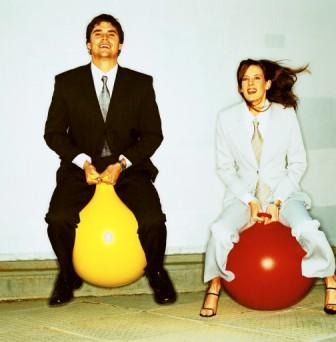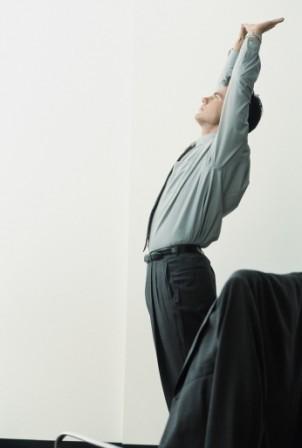Exercises To Combat Desk Syndrome
Are you at risk for desk syndrome? If you work in an office and sit at a desk all day, your body feels the effects. Getting up and moving around from time to time helps increase blood flow, decrease eye strain, and gives your muscles a stretch. The effects of desk syndrome include, but are not limited to: - Sore neck, eye strain and headaches
- Aching back and shoulders
- Decreased oxygen supply due to slouching and shallow breathing
- Low back problems, hip rotations due to sitting with legs crossed
- Tight hamstrings
- Cold hands and feet due to decreased circulation
- Fatigue
There are many ways to combat desk syndrome but the easiest thing to do is to get up every hour and do a lap around the office floor. If your company has several office floors, do a lap around your floor then take the stairs and do a lap around the next floor – you’ll be back at your desk within two minutes if you don’t stop to chat. Your blood will start to flow, delivering fresh blood to your hands and feet and since you’re not slouching (chest out, shoulders back) your quality of respiration will increase delivering more oxygen to your system.

A sore neck, aching back & shoulders, and eye strain are common complaints amongst office workers. An effective way to combat desk syndrome is to take a look at your desk set up:
- Check your chair height relative to desk height. If your desk height is not adjustable, then adjust your chair so that your elbows are at a 90° angle when your hands are on your keyboard. Now check your feet. Are they dangling at this chair height or are they flat on the floor. If they’re not on the floor then get an adjustable foot stool so that your feet are resting on something solid.
- Check your monitor. When sitting at your desk the monitor should be at eye level – this will help keep your head in a neutral position. Perform the chin check. Make an L with your thumb and forefinger and place your thumb at the level of your clavicle (collar bone) along the midline of your body – your chin should be behind your forefinger. If it’s not, you’re placing undue stress on the smaller muscles of your neck to hold your head in a forward position. The smaller muscles will fatigue resulting in muscle knots, a sore neck, back, and shoulders and if left unchecked may result in recurring headaches.
- Eye strain can be alleviated by looking away from your monitor and focusing on something in the distance. This exercise will force your eyes to change the curvature of the lens, engaging the muscles and bringing a fresh supply of blood to the eyes. This should be done several times throughout the day to decrease your level of eye strain. You can also increase blood flow by pressing points around the eyes.
Click here for more information.
By the time afternoon rolls around you’ll need to check your level of slouch. It usually creeps up on you as the day goes on.

- Get up from your chair, grasp your hands above your head and reach for the ceiling, then lower your hands and clasp them behind your back for a chest stretch – pull your shoulders down and back.
- Sit on your chair with feet on the floor/foot stool, rotate torso to one side, grasp arm of chair with both hands and look over the back of your chair for a few seconds. Rotate back to centre and repeat the stretch on the other side.
- Hang right arm over arm rest and tilt head so left ear approaches left shoulder, hold for a few seconds and repeat on the other side.
- Place right ankle on top of left thigh and lean forward at the hip to stretch out your glutes, repeat on the opposite side.
You should now be sitting tall in your chair with shoulders relaxed and ready to work. Remember to use the chin check throughout the day.
Return from Desk Syndrome to My Health Site Home Page
The contents of this site are the opinions of Michele Tse unless otherwise noted. The information on this site is intended for general informational and educational purposes only and is not a substitute for professional medical or nutritional advice or treatment. Please consult your health care practitioner before beginning any fitness program.
|


